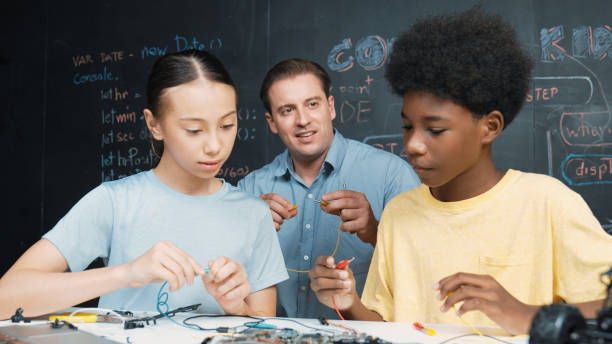In an age when technology often competes with education for students’ attention, finding ways to use it as an ally instead of an obstacle can feel like a daunting challenge. For many schools, the promise of digital transformation has remained just that—a promise. But at one mid-sized K–12 school, a bold approach led by education strategist Chris Bressi turned that promise into reality.
In just one academic year, this school saw student participation triple, teacher engagement rise, and parent satisfaction reach new heights. The results didn’t come from simply adding gadgets or upgrading software. They came from a thoughtful, people-centered strategy that leveraged technology to make learning more interactive, inclusive, and personal.
This is the story of how Chris Bressi helped one school reimagine participation and transform its learning culture.
The Challenge: A School Stuck in Neutral
The story begins at Brookfield Academy, a suburban school with a strong reputation for academics but a growing problem with student engagement. Teachers were noticing that participation had steadily declined—especially in virtual and hybrid settings.
Despite investing in devices and online platforms during the pandemic, the technology wasn’t being used effectively. Students tuned out, discussions were dominated by a few outspoken voices, and teachers struggled to keep lessons dynamic.
By early 2023, the administration knew something had to change. They wanted to rebuild participation both in the classroom and online, but they didn’t know where to start. That’s when they brought in Chris Bressi, a leading education technology consultant known for his ability to merge innovation with real-world teaching experience.
Step 1: Listening Before Leading
When Bressi arrived, he didn’t begin by pitching software or presenting a flashy slide deck. He started by listening.
He met with teachers, students, and administrators to understand their daily experiences. What were the obstacles? What tools were being underused? What did engagement mean to them?
What he found was revealing. Many teachers were overwhelmed by tech tools that didn’t feel intuitive. Students said they wanted more voice in class discussions and projects, while parents wanted clearer visibility into their children’s learning progress.
“Before you can transform a system, you have to understand the people inside it,” Bressi later said. “Technology can’t fix culture—it has to support it.”
Through these conversations, he identified three root problems:
- Technology was being used for compliance, not creativity.
- Students lacked ownership over their learning experiences.
- Teachers weren’t fully supported in using digital tools effectively.
Those insights became the foundation for a bold new participation strategy.
Step 2: Reimagining Participation
Bressi’s first move was to redefine what “participation” meant at Brookfield Academy.
Traditionally, participation had been measured by hand-raising or speaking out during lessons. But that model favored a small group of confident students while leaving many others silent.
Bressi proposed a broader, more inclusive definition. Participation, he argued, could include digital collaboration, peer feedback, online discussion boards, project-based contributions, and even reflective journals. The goal was to recognize every student’s voice—whether it was spoken aloud or expressed digitally.
To put this into action, he introduced a blended participation framework that combined face-to-face interaction with digital engagement. This allowed every student to contribute in ways that felt natural to them.
Suddenly, the quiet student who rarely spoke in class was thriving on discussion threads. The creative student who doodled in notebooks began designing digital infographics to summarize lessons. Technology became a bridge, not a barrier.
Step 3: Choosing Tech That Served People
One of Bressi’s core principles is simple: start with purpose, then choose tools.
After understanding the school’s needs, he worked with the administration to streamline their tech stack. Instead of juggling eight different platforms, they focused on three key tools:
- A collaborative learning platform where students could share work, comment, and reflect.
- A live polling app that allowed real-time feedback during lessons.
- An analytics dashboard for teachers to track engagement patterns.
The goal wasn’t to flood classrooms with new tools, but to use technology that encouraged connection and creativity.
He also helped teachers integrate these platforms into daily instruction without adding extra workload. Each lesson had built-in opportunities for participation—whether through quick polls, shared projects, or digital reflection journals.
“Teachers don’t need more tech,” Bressi often says. “They need better integration and clearer purpose.”
Step 4: Empowering Educators
Bressi understood that technology adoption depends on teachers feeling confident and supported. Instead of delivering one-time training sessions, he developed a coaching-based professional development program.
Teachers worked in small groups to share ideas, troubleshoot challenges, and celebrate wins. They also observed one another’s classes to see engagement strategies in action.
This peer-driven model created a ripple effect. Veteran teachers became digital mentors, while newer educators brought fresh ideas and energy.
Within months, 87 percent of teachers reported feeling more comfortable integrating technology into lessons. More importantly, 92 percent said they saw an improvement in student participation and feedback.
“Chris didn’t just give us tools,” one teacher explained. “He gave us confidence. He made technology feel like something we could shape, not something that shaped us.”
Step 5: Involving Students as Co-Creators
Perhaps the most transformative part of the initiative was how it shifted students from passive participants to active co-creators.
Christopher Bressi helped launch a “Student Voice Council” made up of representatives from different grades. Their mission was to help shape digital learning experiences that worked for their peers.
Students suggested adding weekly “choice boards” that allowed them to select topics or formats for assignments. They also helped redesign digital rubrics to make expectations clearer.
The result was remarkable. Participation in class projects and discussions skyrocketed. Students were not just responding—they were initiating.
“They began to see learning as something they owned,” Bressi said. “And ownership is the foundation of engagement.”
Step 6: Measuring and Celebrating Success
To sustain the momentum, Bressi worked with school leaders to create transparent metrics for participation. These weren’t just numbers; they were stories.
Teachers tracked data through the analytics dashboard, but they also collected qualitative feedback. Students reflected on their engagement each month, sharing what motivated them and what could improve.
By the end of the school year, the results spoke for themselves:
- Student participation increased by 206 percent.
- Average lesson interaction (polls, chats, submissions) tripled.
- Teacher satisfaction rose from 68 percent to 93 percent.
- Parent engagement on digital platforms doubled.
The administration didn’t just see better participation—they saw a stronger sense of community.
To celebrate, Bressi helped organize a “Digital Learning Showcase,” where students presented projects to families and local leaders. It turned into one of the most well-attended events in the school’s history.
Step 7: Sustaining the Momentum
Transformation can fade if it isn’t sustained. Bressi made sure that didn’t happen.
He helped Brookfield Academy establish an Innovation Committee made up of teachers, administrators, and students who met monthly to review progress and share new ideas.
He also recommended keeping professional development continuous rather than seasonal. Teachers began running monthly “Tech and Teach” sessions, where they shared classroom experiences and quick wins.
This ongoing cycle of reflection and renewal ensured that the digital transformation became a living part of the school’s culture—not a one-time project.
The Human Side of Digital Transformation
What made this case study stand out wasn’t just the impressive data—it was the human element at its core.
Bressi’s approach never treated technology as the hero of the story. Instead, he focused on connection, creativity, and confidence.
He often says, “Technology doesn’t engage students. People do. Technology just gives us new ways to reach them.”
By putting people first—teachers, students, and parents—he turned digital tools into catalysts for collaboration and curiosity.
Lessons Other Schools Can Learn
The Brookfield Academy success story holds valuable lessons for any school looking to boost participation through technology:
- Start with people, not products. Listen to your community before choosing tools.
- Redefine engagement. Recognize multiple ways students can participate.
- Simplify your tech stack. Focus on integration and ease of use.
- Empower educators. Invest in training and support, not just equipment.
- Include students in decision-making. Give them ownership of learning.
- Measure meaningfully. Track progress through both data and stories.
- Celebrate often. Recognition builds excitement and accountability.
- Stay iterative. Keep testing, reflecting, and improving.
These principles form a blueprint for sustainable, human-centered digital transformation—one that doesn’t just add technology but amplifies learning.
The Bigger Picture
A year after Bressi’s project ended, Brookfield Academy continues to thrive. Teachers collaborate more closely than ever, students feel seen and heard, and parents remain deeply engaged.
The school has become a model for other institutions seeking meaningful digital change. Its story proves that with the right vision, guidance, and empathy, technology can do more than modernize classrooms—it can bring learning to life.
For Chris Bressi, the outcome is a reminder of what he values most: not the tools, but the transformation of minds and communities.
“Education isn’t about keeping up with technology,” he says. “It’s about using it to help every student find their voice. When that happens, participation isn’t something you measure—it’s something you feel.”




